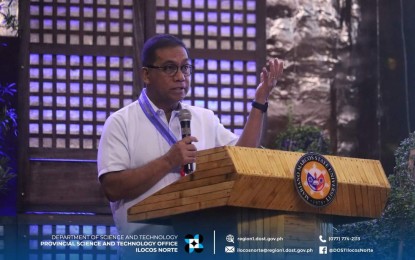
FORUM IN PANGASINAN. Department of Science and Technology Secretary Renato Solidum Jr. during his keynote speech at the Alerto Rehiyon Uno Geohazard Forum in Ilocos Norte on Wednesday (July 19, 2023). Solidum led the same forum in Pangasinan on Thursday (July 20). (Photo courtesy of DOST Ilocos Norte)
LINGAYEN, Pangasinan – Department of Science and Technology (DOST) Secretary Renato Solidum Jr. on Thursday said that abiding by the building code and other structural laws would help prevent or lessen damage to life and properties during strong earthquakes.
“Ang nakakamatay sa mga malalang lindol ay mga bahay at mga mahihinang gusali. Ang nababasag ay concrete like bahay at gusali kaya nararapat na pagtuunan ng pansin kung gaano katibay mga bahay at gusali (What is hazardous during strong earthquakes are structurally weak houses and buildings. Concrete structures such as houses and buildings hence, the need to ensure that these are sturdy houses and buildings),” he said during an interview after he was asked about the possibility of the San Roque Dam to break during a strong earthquake.
Solidum said the dams are usually earth-filled made of mud, sand, and silt, and would not break, unlike concrete.
He said the construction of dams was also well-studied and prepared by proponents considering all aspects including the fault lines around them.
Non-engineered buildings are considered weak structures and are the first to be damaged during strong earthquakes, Solidum added.
“Mas marami sa probinsya ang hindi humihingi ng building permit (Many in the provinces do not seek for a building permit),” he said.
He said part of the preparedness measures for an earthquake is by abiding by the building codes and other laws.
“Dapat inspeksyunin ng local government unit (LGU) ang mga bahay at gusali at ipa-retrofit o ipa-abandon ang mga mahihina (The LGU should inspect houses and buildings and if these are found out to be weak, these should be retrofitted or abandoned),” he added.
Also part of the preparedness of the public is to be aware of what to do and how to be safe during an actual earthquake.
“Ang turo kapag lumindol duck, cover, and hold, at umiwas sa mga maaring mabasag o mahulog. Kapag matibay yong building o bahay, di ‘yon babagsak pero yong mga maaring mabasag o mahulog kailangan iwasan (We are taught to duck, cover, and hold, and to stay away from anything that might break or fall during an earthquake. If the building or house is sturdy, it will not fall but watch out for those that might break or fall),” Solidum said.
He emphasized the need to take the earthquake drill seriously as this would prepare the people for the actual scenario.
Also, he said that there is a need to conduct it in every household and office.
Solidum said search and rescue operations and health responses should be strengthened in case a disaster happens and would result in damages.
Forum on geological hazards
Meanwhile, Solidum encouraged resilience among the LGUs and the residents during the Forum on Geological Hazards in Ilocos Region held in this town.
He said resilience is characterized by three major goals such as to reduce various risks prior to the hazard occurrence through disaster risk reduction; ensuring effective and efficient response when the disaster or hazard occurs through preparedness and responses; and timely and efficient recovery and building forward better after the disaster.
“To put it simply, in building resilience, science technology, and innovation address both risk-reduction and disaster management while the significance of local knowledge,” he said, adding that science, technology, and innovation solutions must be localized.
“Therefore, in addressing climate and disaster risks, we are challenged to have a mindset and approach that are integrative and holistic. To emphasize that through your support and leadership, we will make science work, we will prevent current hazards from becoming disasters and prevent future disasters,” he said.
Solidum also encouraged the LGUs to make use of the GeoRisk Philippines Initiative, which is a platform developed by DOST and other agencies, that gathers and provides information for sharing and analyzing hazards and climate information, collections of exposure data, and risk conducting risk assessments.
He said it has four applications, the GeoMapperPH and PlanSmart that both need credentials to utilize the applications and the GeoAnalyticsPH and HazardHunterPh that are both available to the public. (PNA)
